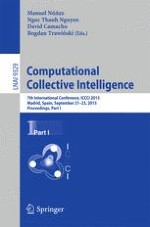This two-volume set (LNAI 9329 and LNAI 9330) constitutes the refereed proceedings of the 7th International Conference on Collective Intelligence, ICCCI 2014, held in Madrid, Spain, in September 2015.
The 110 full papers presented were carefully reviewed and selected from 186 submissions. They are organized in topical sections such as multi-agent systems; social networks and NLP; sentiment analysis; computational intelligence and games; ontologies and information extraction; formal methods and simulation; neural networks, SMT and MIS; collective intelligence in Web systems – Web systems analysis; computational swarm intelligence; cooperative strategies for decision making and optimization; advanced networking and security technologies; IT in biomedicine; collective computational intelligence in educational context; science intelligence and data analysis; computational intelligence in financial markets; ensemble learning; big data mining and searching.
